In the past, capacitive sensors were rarely used in automotive electronics because they were considered difficult to control, difficult to read, prone to aging, and had strict temperature requirements. On the other hand, they also have the characteristics of low production cost, simple form factor adaptation, and low power consumption, which promotes their application. Now, the emergence of a new measurement technology has greatly increased the number of capacitive sensors used in automobiles.
On a macro level, capacitive sensors are usually analyzed by converting capacitance into another physical variable such as voltage, time or frequency. On a micro level, capacitive sensors have long been used in automobiles; micromechanical accelerometers are designed based on this principle. These are often used to detect charge transfer.
A new approach to detecting capacitance uses a modified Σ-Δ converter input stage to detect unknown capacitance and convert it into a digital signal. This approach uses a capacitance-to-digital converter (CDC) and is described in this article along with several capacitance sensor principles that can be used in automotive applications. An alternative approach is also outlined at the end of the article.
Capacitance to Digital Converter
To describe CDC visually, we must introduce the principle of Σ-Δ converter. Figure 1 is a simplified diagram of Σ-Δ converter.
To understand the operation clearly, first we look at the input of the integrator, which must remain at zero over long time intervals. A short, small step signal is transformed into a ramp signal. The zero average value is achieved by raising the output of the reference branch to the same value as the input branch, which in turn is affected by the comparator output. This transforms the reference point into a parallel capacitor with a logical 1.
The capacitor charge is then fed back to the integrator, which gets a negative reference voltage. The high voltage at the input thus results in a large number of logic parts, which in turn frequently apply the (negative) reference voltage. The density is converted into a digital value by the following digital filtering. The classic Σ-Δ converter compares the unknown voltage with a known voltage, i.e., uses two known capacitors (usually equal) to make this comparison.
In fact, the charges are compared, so the capacitance can be compared using the formula Q = C * V, if both voltages are known (here the same voltage value is taken). The synchronous voltage signal must also be provided to the input branch. Figure 2 shows a capacitance-to-digital converter.
This approach brings many benefits. Due to the close relationship with Σ-Δ converters, their well-known characteristics can be improved and adopted, including high noise suppression, high resolution at low frequencies, and high accuracy that can be achieved cost-effectively. Σ-Δ converters, almost without exception, have a similar input structure, so different special structures can be used for special measurement tasks, such as very low current input, maximum accuracy or higher cutoff frequency.
If we look closely at Figure 2, further advantages become clear. Parasitic capacitance plays no role in the initial approximation. A parasitic capacitance that goes to zero at node A has zero potential. Node B is not zero, but it is charged by a definite low impedance potential, so the parasitic capacitance at this node will charge to an average value and will not affect the measurement result. The parasitic capacitance from node A to B is always in parallel with the measurement element and will usually appear as an offset.
Existing capacitance-to-digital converters can provide very good performance. For example, ADI's AD7745 can achieve 24-bit resolution and 16-bit accuracy.
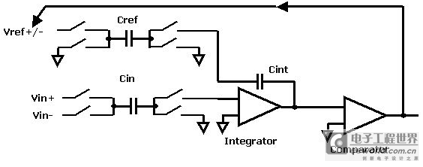
Figure 1: Simplified diagram of a sigma-delta converter
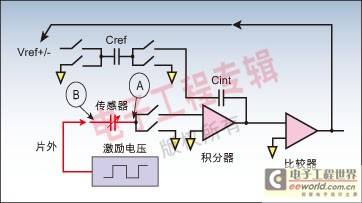
Figure 2: Capacitance-to-digital converter
Capacitive Sensors
Previous capacitive analysis systems required the capacitance being measured to be relatively large, as well as a large change in capacitance upon contact. The need for a sufficiently large change often creates problems for sensor manufacturers that do not arise with smaller capacitive sensors. For example, a typical 150pF humidity sensor is not only quite expensive (because it is relatively large), but is also prone to error and has poor long-term stability. [page]
The capacitance of a capacitor can be calculated based on its structure: C = εoεrA/d
Where εo is the dielectric constant of the vacuum, εr is the dielectric constant of the material, A is the area of the guide plate used, and d is the distance between the two electrodes. With a few exceptions (such as pressure sensors), all capacitive sensors use changes in the surface of the guide plate or the dielectric to measure changes in capacitance. Most sensors can be divided into two categories: one that changes the area (geometry) of the guide plate (such as liquid level sensors or displacement sensors); the other that relies on changes in εr (such as proximity sensors or humidity sensors).
Humidity sensors are a classic example of dielectric sensors, using a humidity-sensitive polymer layer as the dielectric. As humidity increases, more and more water molecules accumulate, so εr increases. The sensor detects the purity of a liquid (such as oil or fuel) and essentially consists of two fixed guide plates. The liquid itself forms the dielectric. The necessary liquid properties are determined empirically (e.g.: increased water content in oil or fuel). The temperature plays a decisive role and must also be reliably determined. Simple proximity sensors that measure changes in the dielectric usually require the most complex measuring electronics.

image 3:
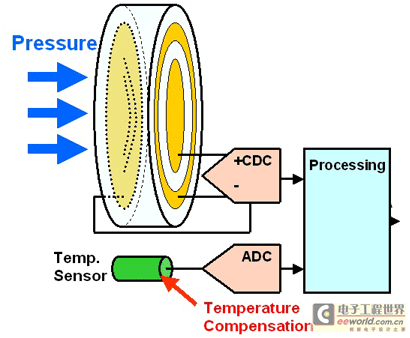
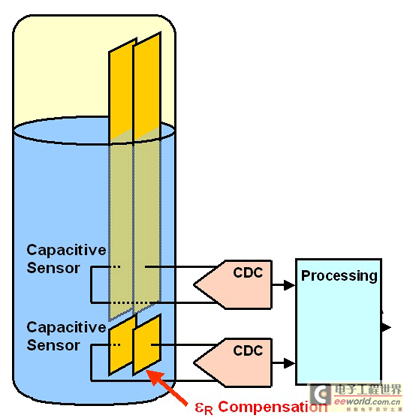
Figure 5:
In many cases, proximity sensors consist of two conductors on a printed circuit board. The value of the dielectric in between is very small (close to 1). If an object, such as a hand, moves into the electrical region of the capacitor, it changes the capacitance. The human body is composed of more than 90% water, so the value of the dielectric is very large (about 50).
Remote switches are very easy to manufacture, making applications such as keyless ignition or clamping protection for power windows possible. An important requirement for keyless cars is to keep the input current as low as possible - less than 100A is the norm. Manufacturers have optimized Σ-Δ converters over the years, so there are already some suitable architectures.
Rain sensors can be implemented in a similar way. They are easy to manufacture, cost-effective, and size can also be an advantage. However, traditional rain sensors based on the optical refraction of water droplets have only a very small active area on the windshield, which reduces the sensitivity of the system and leads to repeated dry wipe and no wipe problems. [page]
Geometry Change Sensor
Examples of sensors that rely on geometric changes are pressure sensors, level sensors, and displacement sensors - these sensors simply move a dielectric between fixed guide plates. Pressure sensors use two guide plates of fixed dimensions as a diaphragm; because the guide plates are flexible, pressure on the sensor changes the distance between them.
Temperature sensors require a changed geometry due to thermal diffusion. Imagine that one of the two electrodes is attached to the chip and the other to a support made of metal or ceramic, which thus acts as a sensor itself. Ceramics, for example, are able to withstand very high pressures and aggressive media. The main advantage of capacitive pressure sensors compared to the classic Wheatstone bridge is the lower input current requirements, making them particularly suitable for applications such as tire pressure control.
In a level sensor, a pair of fixed guide plates are immersed in the liquid to be measured. Manufacturers can make printed conductors at very low cost. A second pair of guide plates is attached to the bottom and can detect changes in the dielectric due to temperature or other effects, as shown in the figure below.
In all approaches, the sigma-delta technique has proven to be very satisfactory. In many cases, digital filters are necessary anyway and they can be used to achieve the required dynamic characteristics. For example, very long time constants are required in hydraulic sensors, and proximity sensors must adapt to changing ambient conditions (such as humidity sensors to rain or ice).
Alternative Methods Using DDS Technology
This technique works in a completely different and slightly more complex way. On the other hand, it can be used to measure complex impedances, including inductive, impedance/capacitive or impedance/inductive sensors. In this case, the sensor is excited by a very precise known frequency. Here, direct digital synthesis (DDS) technology is very suitable.
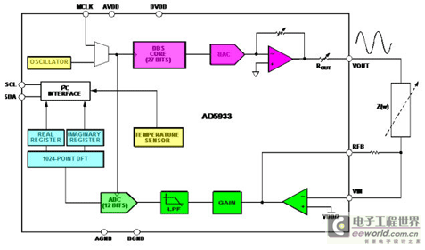
Figure 6: Calculation of the real and imaginary parts of impedance using the DDS method
Here, the sensor's response is recorded via a fast analog-to-digital converter and a fast Fourier analysis. Using the DDS method, the initial phase is known precisely at all times. In the same way, the response to other frequencies can also be measured. The real and imaginary parts of the impedance can be calculated from this and output via the digital bus. A complete scan takes only a few hundred milliseconds. This figure illustrates the method.
This network analyzer circuit can be used with capacitive and inductive sensors, as well as sensors that record motion or measure the viscosity of liquids, such as engines or lubricating oils.
summary:
Capacitive sensors are experiencing a new lease of life in automobiles. New approaches have demonstrated initial success in pressure, level, humidity, rain, and proximity sensors. The use of Σ-Δ technology provides flexible solutions for different dynamic and accuracy requirements and enables sensor systems with extremely low power requirements. CDC devices are already used in several automotive applications and are increasingly being used in many other areas.
Previous article:Miniaturized Isolation Amplifier for Current and Voltage Measurement in Small Wind Power Systems
Next article:Using EDA tools to improve the efficiency of system-level chip testing
Recommended ReadingLatest update time:2024-11-16 13:43
- Popular Resources
- Popular amplifiers
- Keysight Technologies Helps Samsung Electronics Successfully Validate FiRa® 2.0 Safe Distance Measurement Test Case
- From probes to power supplies, Tektronix is leading the way in comprehensive innovation in power electronics testing
- Seizing the Opportunities in the Chinese Application Market: NI's Challenges and Answers
- Tektronix Launches Breakthrough Power Measurement Tools to Accelerate Innovation as Global Electrification Accelerates
- Not all oscilloscopes are created equal: Why ADCs and low noise floor matter
- Enable TekHSI high-speed interface function to accelerate the remote transmission of waveform data
- How to measure the quality of soft start thyristor
- How to use a multimeter to judge whether a soft starter is good or bad
- What are the advantages and disadvantages of non-contact temperature sensors?
- Innolux's intelligent steer-by-wire solution makes cars smarter and safer
- 8051 MCU - Parity Check
- How to efficiently balance the sensitivity of tactile sensing interfaces
- What should I do if the servo motor shakes? What causes the servo motor to shake quickly?
- 【Brushless Motor】Analysis of three-phase BLDC motor and sharing of two popular development boards
- Midea Industrial Technology's subsidiaries Clou Electronics and Hekang New Energy jointly appeared at the Munich Battery Energy Storage Exhibition and Solar Energy Exhibition
- Guoxin Sichen | Application of ferroelectric memory PB85RS2MC in power battery management, with a capacity of 2M
- Analysis of common faults of frequency converter
- In a head-on competition with Qualcomm, what kind of cockpit products has Intel come up with?
- Dalian Rongke's all-vanadium liquid flow battery energy storage equipment industrialization project has entered the sprint stage before production
- Allegro MicroSystems Introduces Advanced Magnetic and Inductive Position Sensing Solutions at Electronica 2024
- Car key in the left hand, liveness detection radar in the right hand, UWB is imperative for cars!
- After a decade of rapid development, domestic CIS has entered the market
- Aegis Dagger Battery + Thor EM-i Super Hybrid, Geely New Energy has thrown out two "king bombs"
- A brief discussion on functional safety - fault, error, and failure
- In the smart car 2.0 cycle, these core industry chains are facing major opportunities!
- The United States and Japan are developing new batteries. CATL faces challenges? How should China's new energy battery industry respond?
- Murata launches high-precision 6-axis inertial sensor for automobiles
- Ford patents pre-charge alarm to help save costs and respond to emergencies
- New real-time microcontroller system from Texas Instruments enables smarter processing in automotive and industrial applications
- How does the Allwinner V853 chip support the ssh function?
- Tina ti cannot simulate LC oscillation circuit!
- USB network port module test based on TI Sitara Cortex-A8
- How to output multiple pulses?
- Network port control output TTL module
- Power charging circuit
- I don't understand the ref102 data sheet and the circuit diagram. Please help me.
- A video to understand common electrical interfaces and principles_SPI I2C UART 8080 6800 sram sdram----The key is free
- How do I convert 51 code to STM32 driver code?
- Please help, how does this circuit work?

 Computer Vision Applications in Autonomous Vehicles: Methods, Challenges, and Future Directions
Computer Vision Applications in Autonomous Vehicles: Methods, Challenges, and Future Directions
















 京公网安备 11010802033920号
京公网安备 11010802033920号